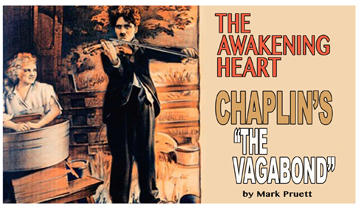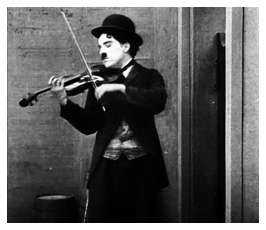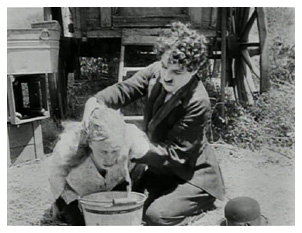

With The Vagabond (1916), Charlie Chaplin proved
that characters in a comedy could move an audience as compellingly
as characters in a drama. Depth of feeling, foreign to slapstick
comedy generally, was rare even in Chaplin's early work. Chaplin's
artistry grew as his control over production increased, and from
the Keystone days through his best work at Essanay we see him
steadily refining and polishing -- gags and business, of course,
but especially the iconic figure he had brought into being in
1914. By the time of the Mutual films this figure was less the
Tramp than "the little fellow," occupying whatever role
the present story required (fireman, wealthy toff, pawnshop employee,
policeman) but remaining the same person from film to film, a
romantic outsider, much-buffeted yet ever resilient, ever hopeful.
The Vagabond was the third film to be released under Chaplin's
Mutual contract, but it feels like the first. This is due to its
extraordinary beginning: two floppy, splayed shoes, topped by
baggy pants, shuffle toward the camera from beneath the double
doors of a saloon. Throughout the world reached by moving pictures
in 1916, no habitual moviegoer would have been in the least doubt,
during these fleeting seconds, as to the owner of the bunched
trousers and oversized shoes. Instant recognition was no mere
byproduct of celebrity but the stunning proof of Chaplin's global
reach, of fame raised to a power unmatched by any artist in any
medium at any previous time in history.
By 1916 Chaplin's little fellow had become his own logo. The next
moments of The Vagabond acknowledge this. The saloon doors
part and the little fellow emerges, clutching his violin, to stand
before us in the center of the screen. We see him tip to toe,
full figure, his derby barely clearing the top of the frame, his
shoes nearly touching the bottom. It is a singular moment in  the Mutuals, perhaps in all of
Chaplin. Whether projected onto a state-of-the-art Mirroroide
screen or a white plaster wall, Chaplin's image would have loomed
large, filling the vertical space more imposingly than the soon-to-be-familiar
Goldwyn Pictures lion, the Pathé News rooster, or the Paramount
peak. The pose, held for several seconds, is a mute proclamation,
rendering title cards superfluous. It says, You know who I am
whether you can read or not. But if you can read, then yes, I
am the fellow your newspaper describes as the highest paid entertainer
in the world. And I am here once again to show you why.
the Mutuals, perhaps in all of
Chaplin. Whether projected onto a state-of-the-art Mirroroide
screen or a white plaster wall, Chaplin's image would have loomed
large, filling the vertical space more imposingly than the soon-to-be-familiar
Goldwyn Pictures lion, the Pathé News rooster, or the Paramount
peak. The pose, held for several seconds, is a mute proclamation,
rendering title cards superfluous. It says, You know who I am
whether you can read or not. But if you can read, then yes, I
am the fellow your newspaper describes as the highest paid entertainer
in the world. And I am here once again to show you why.
Many in the audience would already have gasped at reports of the
$670,000 salary guaranteed to Chaplin for furnishing twelve short
comedies, one per month, to the Mutual Film Corporation. His first
effort under the new contract, The Floorwalker, boasted
an elaborate department store set, complete with a moving staircase.
Unlike the typical Keystone or Essanay short, the comedy was expensively
produced and looked it. Yet neither The Floorwalker nor
its follow-up, The Fireman, had the touch of pathos that
had so distinguished The Tramp, released by Essanay barely
a year earlier. The Vagabond reintroduces sentiment to
Chaplin's comedies. From here on, in many of the shorts and in
all of the silent features, the little fellow will face situations
in which something of vital importance -- life, love, liberty
-- stands to be lost.
In outline, The Vagabond is the stuff of melodrama. A young
woman, forced to work as a drudge for a band of abusive gypsies,
is revealed to be the kidnapped daughter of a wealthy society
woman. An itinerant violinist, decent but penniless, ignorant
of the young woman's past, comes to her rescue -- and falls in
love with her. But he must stand by, helpless to assert his love,
as she is identified (by a birthmark) and restored to her wealthy
family.
Kidnappings by gypsies, Peter Kobel reminds us, figured in silent
films as early as Cecil Hepworth's Rescued By Rover (1905).
They were central to the plot of both D. W. Griffith's The
Adventures of Dollie (1908) and Edison Studios' The Girl
of the Gypsy Camp (1915). Chaplin thus chose to build his
third comedy for Mutual on a conventional, even overfamiliar,
storyline. The laughs in The Floorwalker and The Fireman
were more or less bounced off the setting, but in The Vagabond
they emerge from the little fellow's sudden entanglement in an
ongoing and potentially tragic series of events.
Chaplin brings this off not only with a nod to theatrical tradition
(that fount of melodrama) but with a cinematic intelligence rarely
attributed to him. Historians are right to point out that Chaplin
liked to park his camera and spend his time instructing each of
his actors what to do in front of it. But it's a mistake to assume
that his respect for the proscenium made him any less dedicated
to the exciting possibilities of cinema. His camera does move,
but seldom without a good reason. He is as alive to what is inside
the frame as to the ways in which individual shots can be manipulated.
In The Vagabond we see his increasing sensitivity to proportion,
contrast, and the telling arrangement of objects and people. He
establishes the characters of the violinist, the society woman,
and the kidnapped daughter with a deft visual shorthand that --
in a two-reel comedy from 1916 -- is nothing short of astonishing.
We know more about the "Street Musician"-- Chaplin's
stated role -- in the first minute of the film than any title
card could have told us. The little fellow leaves the swinging
doors of the saloon and walks away from us along the side of the
building. The camera stubbornly refuses to move, so that the retreating
figure is confined to a narrow column of space at the extreme
left of the screen, while three-quarters of the screen, depicting
the front of the saloon, remains unoccupied. After some brief
comic business, the camera resumes this vantage point -- and all
at once we understand why. A robust German band, five big men,
show up and begin to play in front of the swinging doors. The
violinist, meanwhile, saws away outside the tavern's "Family
Entrance" at the far end of the narrow corridor, his figure
shrunk by distance to a fraction of the size of the foreground
figures. The shot is deep focus before deep focus had a name,
and it reveals in an instant the social status of Chaplin's little
fellow. Literally reduced, literally marginalized, he is shown
to be alone, scuffling for work, and keeping -- or being kept
-- to the periphery.
We understand the world of the society woman by first understanding
what it isn't. From the rough-and-tumble of the saloon, we jump
to a richly appointed drawing room. We might have stumbled into
one of Cecil B. DeMille's domestic dramas of the 1920s, but not
even DeMille's upper-class interiors were this ornate. There are
Persian rugs, paintings, upholstered furnishings, glassed cabinets,
candelabra and wall sconces, vases of fresh flowers, even a massive
crystal chandelier, all of it redolent of European refinement
-- of wealth, elegance, stately reserve. It could not be more
different from the grimy saloon. Yet the opening shot of the room,
as the camera begins a slow pan, is explicitly modeled on the
opening shot of the saloon. The tavern's swinging doors are echoed
here in the draped doorway that reveals, beyond the opulent drawing
room, a second room containing heavier furniture, a fireplace,
and a large painting. On both sides of the doorway hang small
oval portraits that recall the two oval signs ("Cool Beer")
flanking the double doors of the saloon.
Chaplin aligns the two doorways, and the very different worlds
they represent, without lingering over the comparison. He doesn't
need to. The scene introducing "The Mother" takes up
a mere 37 seconds of screen time, yet it convinces us of the crushing
emptiness of her life. After watching a dozen men brawl in a saloon,
we find ourselves in sedate rooms devoid of people, or nearly
so. The camera drags our gaze from a vacant loveseat, bench, and
chair, past the gaping doorway, to a table where the mother sews,
clearly alone with her thoughts, beside an older female companion.
When the mother finds a small framed portrait -- the picture of
a young girl -- in her sewing basket, she is visibly grief-stricken.
We are already prepared to say why. Surrounded by sumptuous possessions,
the mother has been denied the only possession that really matters:
her own daughter.
The portrait of the little girl provides a poignant link to the
scene introducing her older self. As the mother's companion leans
over the table to pick up the portrait, the words "The Gypsy
Drudge" appear on a title card. We iris out on the face of
Edna Purviance, looking distressed and haggard, her cheeks mottled
with dirt and her hair in a tangle. But as it frames her anguished
features, the iris pauses. For nearly three seconds, Edna's sad,
haunting face, like a picture squeezed into a locket, is all we
can see on the darkened screen. Then the iris opens out and we
are confronted with the squalid reality of her life in the gypsy
camp. It's a heart-rending moment, beautifully realized in the
camera.
Into this world the little fellow wanders, and the fun resumes.
Here, as in the feature comedies to come, gags are played off
the mood of the moment, and the mood is determined by what is
at stake in the scene.
Despite his characteristic sympathy for the underdog, Chaplin
wastes no affection on the peasant gypsies and gives them little
in the way of comic business. They are almost to a man (and woman)
shown to be oafish brutes who deserve the punishment the little
fellow doles out (clonking them on the noggin with a hefty stick).
As the "Gypsy Chieftain," Eric Campbell gets at least
one good laugh when he leads the chase to recapture the fleeing
caravan. After Edna clonks him, he collapses in the road and is
dutifully tripped over by every single gypsy -- seven in all --
running behind him. Despite the buffoonery, Campbell is for the
most part a scary presence in the film, scarier than the vicious
ruffian he would portray in Easy Street.
Few characters in Chaplin's films are immune to satire, and some
of The Vagabond's funniest moments are at Edna's
expense. Her standards of hygiene, after years of living rough,
offend even the dusty Charlie. When she joins him outside the
caravan the morning after their escape, she is a slovenly sight
to behold. Her clothes are ragged and disordered, her face is
filthy, her hair sticks out in clumps. Charlie stares at her as
she scratches her scalp and helpfully hands her a garden rake.
When she shows no interest in his proffered bar of soap, preferring
to complete her morning toilet by dabbing a wet finger beneath
each eye, he finally takes matters in hand and sits her in front
of a bucket of water.

Edna's wash-up, during which Charlie scrubs her face, ears, and
nostrils with a soapy sock and meticulously dries them with a
flannel shirt, may be the tenderest scene in all of Chaplin's
short comedies. Purviance, a placidly beautiful woman, had never
looked so bedraggled on film, and we can imagine audiences of
1916 taking delight in the transformation. Edna endures the scrubbing
much as a child would, squinting and blowing against the suds
-- but not protesting. Charlie's attentions, as automatic as they
are intimate, express the loving parental care she has been denied
since her kidnapping.
Chaplin's most pointed jabs are reserved for the leisured classes.
Even the little fellow's highbrow airs are ridiculed. Brandishing
his violin, he first plays so violently that he tumbles backwards
into a water barrel and sends Edna crashing over her washtub.
His performance concludes with a flurry of pretentious curtain
calls -- a hilarious bit which, thanks to Chaplin's superb mimicry,
combines the virtuoso's humility in the face of applause with
the vanity that keeps him coming back for more. The sequence ends,
as it must, with another pratfall into the water barrel.
He takes a more penetrating look at the real upper class. While
the painter who discovers Edna in the woods is charming and affable,
he is also something of an aesthete with time on his hands. He
is inspired to paint Edna as "The Living Shamrock,"
but he gives no indication that he means to rescue her from the
wretched conditions of her existence -- or even to pay her a return
visit. Only the wealthy mother's chance sighting of his finished
painting (depicting a vivacious, idealized Edna, with no hint
of the gypsy drudge) leads him to retrace his steps. The first
thing Charlie does upon seeing the painter again (now attired
in top hat and tails) is to drop a handful of eggs on his shoes.
We may laugh at the painter -- Charlie ends by shaking his hand
-- but we are not encouraged to laugh at the mother. Or admire
her, it turns out. At last reunited with her daughter, she can
barely conceal her disdain for Edna's true savior, the vagabond
in ill-fitting clothes. Drawing Edna to her, she extends some
folded bills which the little fellow, with a wise, dismissive
gaze, brushes aside.
Chaplin's unsparing portrayal of the mother sets the stage for
the film's conclusion. All but swept off her feet, Edna rides
away in a cloud of dust with her mother, the painter, their well-dressed
friends, a footman, and a chauffeur. Then, suddenly realizing
who it is she really loves, she forces the car to turn around
-- and invites the little fellow along. The ending -- her return,
his going off with her -- has been criticized as being unlikely
or unrealistic. Lack of realism is a peculiar charge to bring
against any Chaplin comedy, but it is particularly misleading
with regard to The Vagabond. Far from seeming improbable
or gratuitous, the film's final scenes carry a genuine emotional
wallop. Edna's "awakening" in the back seat of the car
-- her growing unease, her looking back, her impassioned cry --
is utterly convincing, flooding the screen with emotion without
the use of a single dialogue title. Chaplin has made sure we can
read every word on her lips:
We watch from the camp as the car speeds away again, carrying
Edna and Charlie toward a future impossible to foresee. Thanks
to Chaplin's subtle magic, our hearts go with them.
Copyright 2014 by Mark Pruett. All rights reserved.